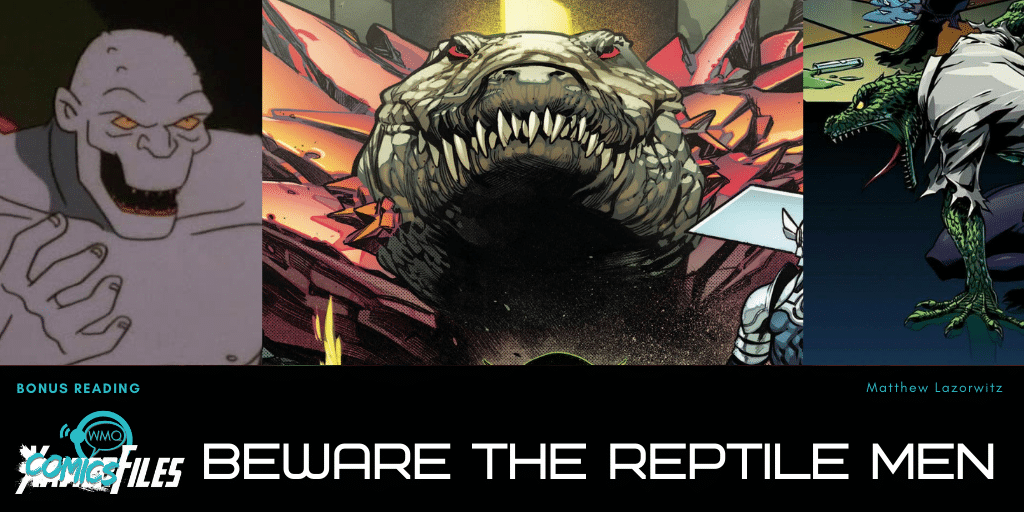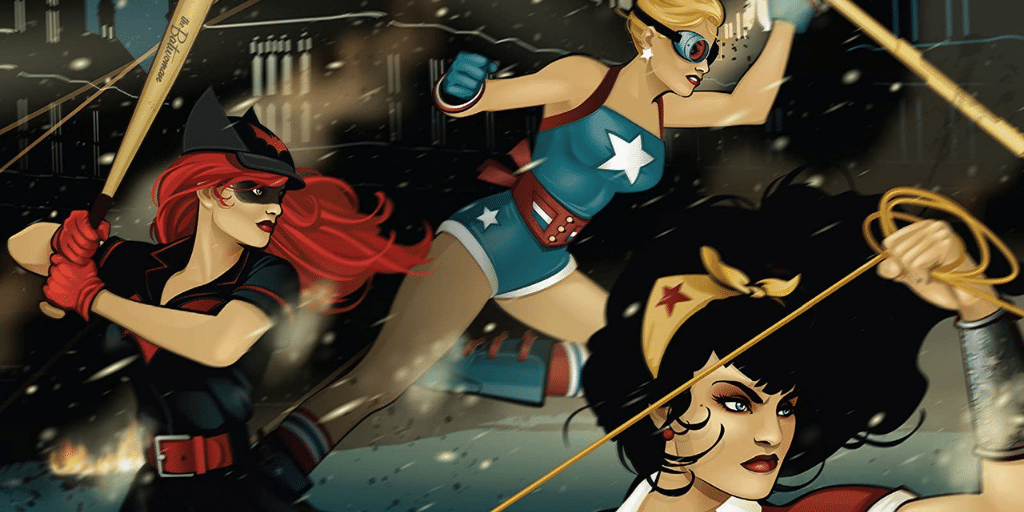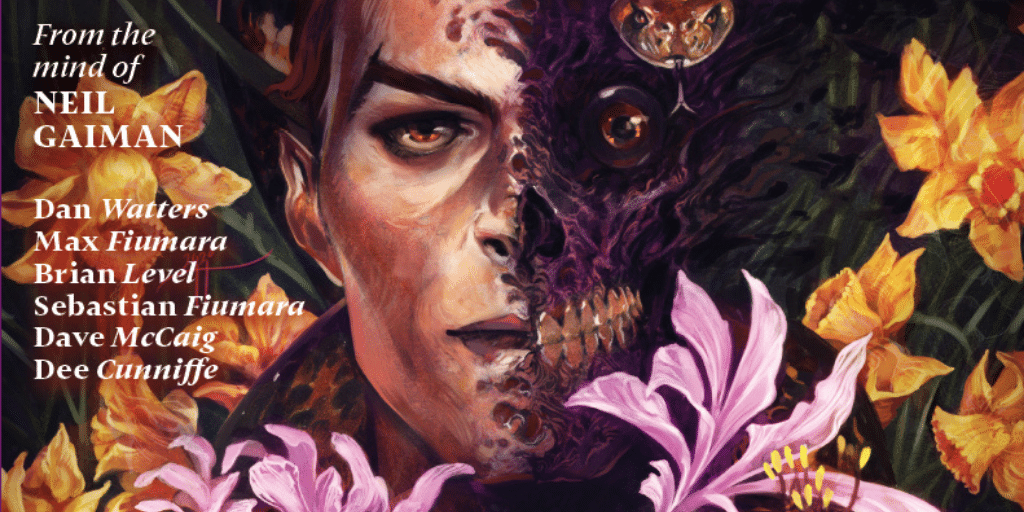
If you read pretty much any coverage on Xavier Files other than my pieces (and if you are just reading my pieces, thanks, but there’s a lot of other great stuff on here. Go read that, too!), you will have seen a trend since the initial art previews for “X of Swords” were released. And that trend would be “POGG UR-POGG! Look at him! Ahhhhhh, he’s so cool!”
And I’m not going to say that is wrong. He’s a multi-armed crocodile monster; what is there not to love? And this week he made his actual debut, in “X of Swords: Stasis” #1, so we’ll see if he is as awesome as he seems. I personally will be a little upset if Pogg Ur-Pogg doesn’t play the game pogs, a ’90s fad not unlike Adam X the X-Treme. But I digress.
So to celebrate the debut of a crocodile monster in the X-Universe, let’s look at four other reptile men in comics in this week’s Bonus Reading.
The Lizard

When it comes to reptile men in comics, the most on-the-nose, and longest lasting, has been the Lizard, a nemesis of that amazing web crawler, Spider-Man. Debuting all the way back in 1963’s “Amazing Spider-Man” #6, Dr. Curt Connors is one of those villains with a tragic backstory whom you can’t help but feel sorry for, despite whatever misdeeds he might perpetrate.
Connors was a celebrated surgeon and scientist who lost his arm while serving as an Army medic. Seeking to find a way to help himself and other amputees, he began researching the way lizards regrow limbs, and being a Silver Age scientist, when he had a serum to test, he tested it on himself. And while his arm did regrow, he also transformed into a lizard monster. The Lizard first encountered Spider-Man when the hero was investigating sightings of the creature in a Florida swamp for the Daily Bugle. Spidey was able to cure Connors using notes the scientist left behind.
Connors moved to New York City with his wife, Martha, and son, Billy, to teach at Empire State University, where he became a mentor to Peter Parker and an adversary for Spider-Man. Connors would still transform into the Lizard when under stress or when exposed to certain chemicals, and would often attempt to transform all of Manhattan or the world into lizards like him. Lizard stories varied from the supremely weird, as when he somehow passed muster and was recruited by the Beyonder to fight in the original “Secret Wars,” to the dark, like when he was mind-controlled by the sorceress Calypso in the first arc of Todd McFarlane’s “Spider-Man” series. Recent Lizard stories have leaned heavily into the tragic, with the death of Connors’ wife and son, the latter of whom was … consumed by the Lizard while in a more mindless form. Don’t worry, though, he got better.
The Lizard has featured heavily in Spider-Man’s appearances in other media. He is one of only a handful of rogues to appear in every iteration of Spider-Man in animation, including the pilot episode of the 1994 series. Connors appeared in the Sam Raimi Spider-Man films, played by Dylan Baker, and the Lizard was the principal antagonist of the film “The Amazing Spider-Man,” played by Rhys Ifans.
One final note: In the alternate world of Spider-Gwen, it was Peter Parker who transformed into the Lizard, and his tragic death was part of what inspired Gwen’s super-heroic actions.
Killer Croc

Waylon Jones, the Batman rogue known as Killer Croc, has evolved, or devolved, considerably since his first appearance. When he was introduced in “Detective Comics” #524, Croc was just a mobster with a skin condition, one that made his skin appear like scales. He was well built, slightly stronger than human norm and his skin was harder to puncture than normal skin, but he was mostly human. He was responsible for the death of Jason Todd’s parents in his earliest appearances, but after that first arc, became a minor Batman foe for many years.
Croc returned to prominence around the time of 1993’s “Knightfall,” where he fought, and was defeated by, Bane. These stories began Croc’s slow descent into a more animalistic state. While his body remained mostly human, he became cannibalistic and more like an animal. Exposure to a chemical compound developed by Hush and his cohorts began transforming Croc into an even more animalistic state, giving him an elongated face and a tail. While stories would occasionally revert him to his original appearance, this became Croc’s default form for much of the next decade.
The New 52 and Rebirth actually did quite a bit of good for Croc. His appearance has varied between the monstrous crocodile-man form and something closer to his original form, but still a bit more monstrous. He also has been more intelligent than the savage Croc of his formerly devolved form. He served as a friend and sponsor to Arsenal, Roy Harper, and was a member of the Suicide Squad. His most recent appearances have given him a more antihero persona, serving as a member of a team of Gotham City horror heroes in “Gotham City Monsters” and as a protector of the underclass during “Joker War,” even though he was transforming people into animal-human hybrids to expand his community at the end.
Croc has appeared in most of the modern animated Batman incarnations, with the often derided “The Batman” finally giving him an accent from Louisiana, where the character has canonically had origins. He also made his live-action debut as a member of the Suicide Squad in the team’s 2016 feature debut.
Herkimer/Sobek
Captain Marvel, the Shazam one, has an absolutely fascinating history, supporting cast and rogues gallery. The fact that he’s sort of played second fiddle to Superman for years now, after he outsold him for periods of the Golden Age, has meant many of those weird and wild characters are forgotten, or are footnotes. Some, like Fat Marvel, are probably better forgotten, but the Crocodile Men are definitely due a revisiting.
Introduced as members of Mr. Mind’s Monster Society of Evil, the Crocodile Men were aliens from the planet Punkus. Their leader, Herkimer, became Mr. Mind’s right-hand man during his time in the Monster Society. After he left Mind’s service, he retired to happily work in a carnival, because, well, it was the Golden Age, and even though that last story with him in the circus was a Silver Age story, those Captain Marvel stories were Golden Age throwbacks.
In the modern DCU, the alien Crocodile Men were forgotten, but a new crocodile-like character was introduced into the Shazam mythos. During “52,” Osiris, the young brother-in-law of Black Adam, found a crocodile man hiding out on the estate of Captain Marvel’s other main rogue, Dr. Sivana. Osiris named the comically cowardly and always hungry Sobek after the crocodile-headed god of the Nile, and he became the Black Adam Family’s mascot, like the anthropomorphic tiger Mr. Tawky Tawny was to Captain Marvel’s. But because the Black Adam parts of “52” were written by Geoff Johns, and that means any comedic thing is going to swing around to gore and horror, it turned out Sobek was one of the genetically created Four Horsemen of the Apocalypse, Yurrd the Unknown, embodying Famine, and when his hunger became overwhelming, he turned on his one friend and bit Osiris in half and devoured him. When Black Adam discovered this, he killed Sobek and had him made into crocodile boots. Because Johns loves old comics and never stops reminding us of that as he makes them into a horror show.
Leatherhead

The Teenage Mutant Ninja Turtles have all manner of animal nemeses and allies, so it makes sense that one of them would be of the crocodile persuasion. That character is, in fact, Leatherhead, who is a mutated crocodile ally of the turtles.
Going into any character from the TMNT mythos is something of a Herculean task, as there are at least three distinct comics continuities and four animated ones, plus three movie continuities, and while Leatherhead is a character who only appears occasionally, he is in at least six of those 10 continuities, so there’s a lot to wade through.
Leatherhead’s origin is usually tied to him being a subject of experiments by the Utrom, the brain-like aliens that are the source of the mutagen that helped create the turtles. Leatherhead invariably escapes the Utrom, or in some continuities specifically Kraang, the evil rogue Utrom, and lives in the sewers of New York, where he meets and befriends the Turtles. The only real exception to this origin is in what is probably the most well known TMNT media, the classic animated series. There, he was accidentally exposed to mutagen in the bayou and became a Cajun-accented mutant villain who hunted the Punk Frogs, allies of the Turtles, and would sometimes team up with Shredder and Krang.
Honorable Mention: Sauron

Dinosaurs are not, in the strictest sense of the word, reptiles, so I did not include any of the myriad dinosaur people in comics on this list. However, at the request of editor Dan Grote, I did add an honorable mention of Sauron, the mutant world’s major dinosaur-themed nemesis. Dr. Karl Lykos absorbs life energy, and when it is mutant life energy, he turns into a pteranodon man in cut-off jorts. He’s been around since the late Silver Age, and is just one of those characters that embodies comic book nonsense. [Grote’s note: Plus he doesn’t want to cure cancer, he wants to turn people into dinosaurs.]
Matt Lazorwitz read his first comic at the age of 5. It was Who's Who in the DC Universe #2, featuring characters whose names begin with B, which explains so much about his Batman obsession. He writes about comics he loves, and co-hosts the podcasts BatChat with Matt & Will and The ComicsXF Interview Podcast.








